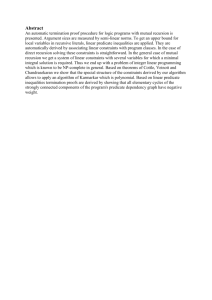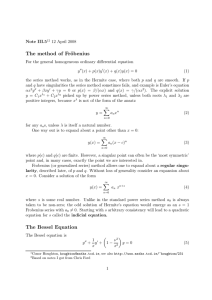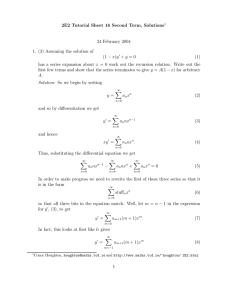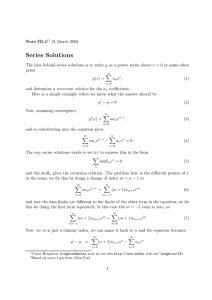2332 Tutorial Sheet 2 1. Use the recursion relation 2(n − α)a
advertisement
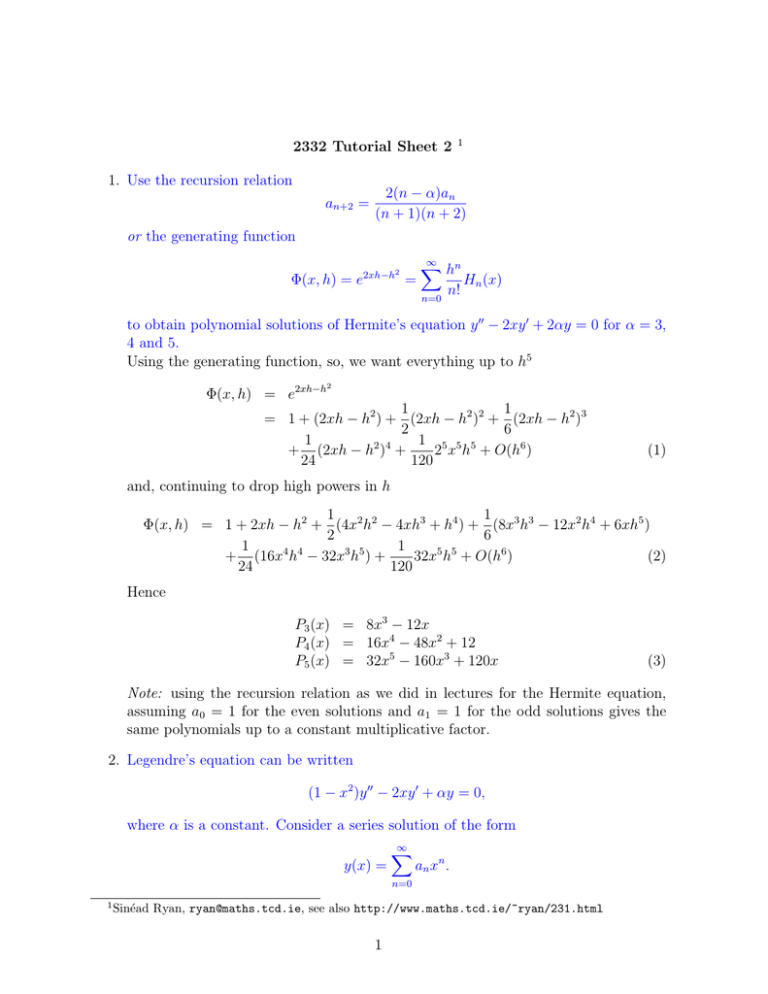
2332 Tutorial Sheet 2 1. Use the recursion relation an+2 = 1 2(n − α)an (n + 1)(n + 2) or the generating function 2xh−h2 Φ(x, h) = e = ∞ X hn n=0 n! Hn (x) to obtain polynomial solutions of Hermite’s equation y 00 − 2xy 0 + 2αy = 0 for α = 3, 4 and 5. Using the generating function, so, we want everything up to h5 2 Φ(x, h) = e2xh−h 1 1 = 1 + (2xh − h2 ) + (2xh − h2 )2 + (2xh − h2 )3 2 6 1 5 5 5 1 2 4 2 x h + O(h6 ) + (2xh − h ) + 24 120 (1) and, continuing to drop high powers in h 1 1 Φ(x, h) = 1 + 2xh − h2 + (4x2 h2 − 4xh3 + h4 ) + (8x3 h3 − 12x2 h4 + 6xh5 ) 2 6 1 1 4 4 3 5 5 5 + (16x h − 32x h ) + 32x h + O(h6 ) (2) 24 120 Hence P3 (x) = 8x3 − 12x P4 (x) = 16x4 − 48x2 + 12 P5 (x) = 32x5 − 160x3 + 120x (3) Note: using the recursion relation as we did in lectures for the Hermite equation, assuming a0 = 1 for the even solutions and a1 = 1 for the odd solutions gives the same polynomials up to a constant multiplicative factor. 2. Legendre’s equation can be written (1 − x2 )y 00 − 2xy 0 + αy = 0, where α is a constant. Consider a series solution of the form y(x) = ∞ X an x n . n=0 1 Sinéad Ryan, ryan@maths.tcd.ie, see also http://www.maths.tcd.ie/~ryan/231.html 1 Determine a recursion relation for the an coefficients. For what values of α does Legendre’s have polynomial solutions? P∞equation P∞ P n 0 n−2 y(x) = P xn−1 , y 00 (x) = ∞ Therefore n=0 an x , y (x) = n=0 nanP n=0 n(n − 1)an x ∞ ∞ 0 n 2 00 n xy (x) = n=0 nan x and x y (x) = n=0 n(n − 1)an x . Relabel y 00 (x) (n = m + 2) 00 y (x) = ∞ X m am+2 (m + 2)(m + 1)x = m=−2 ∞ X am+2 (m + 2)(m + 1)xm . m=0 The last step used that the first two terms in the sum are zero. The ODE can be written (1 − x2 )y 00 (x) − 2xy 0 (x) + αy(x) ∞ X xm [am+2 (m + 2)(m + 1) − am m(m − 1) − 2mam + αam ] = m=0 = 0, (4) giving the recursion relation am+2 = m(m + 1) − α am . (m + 2)(m + 1) If α is of the form n(n + 1) (n = 0, 1, 2, ...) one of the solutions of the ODE will be a polynomial since the recursion relation will terminate. 3. (Frobenius training exercise) For each of the following equations obtain the indicial equation for a Frobenius series of the form y(x) = ∞ X an xn+s n=0 . (a) y 00 + y = 0. P n+s Frobenius: y =P ∞ where s is to be determined. Differentiating twice n=0 an x 00 gives y (x) = (n + s)(n + s − 1)xn+s−2 (most singular P term in ODE). Relabel this as y 00 (x) = a0 s(s − 1)xs−2 + a1 (s + 1)sxs−1 + ∞ m=0 am+2 (m + s + 2)(m + m+s s + 1)x and so y 00 (x) + y(x) = a0 s(s − 1)xs−2 + a1 (s + 1)sxs−1 ∞ X + xm+s [am+2 (m + s + 2)(m + s + 1) + am ] = 0. m=0 Take a0 = 1. The indicial equation is s(s − 1) = 0, 2 with roots s = 0 and s = 1. s = 0 For this s can take a1 6= 0 but for now set a1 = 0. Recursion relation: an+2 (n + 2)(n + 1) + an = 0 or an+2 = − an , (n + 2)(n + 1) 1 , a4 = which is particularly easy to solve a0 = 1, a2 = − 1·2 The solution is ∞ X (−1)p x2p y(x) = = cos x. (2p)! p=0 1 , 1·2·3·4 ..., a2p = (−1)p . (2p)! Including a1 6= 0 gives y(x) = cos x + a1 sin x. The s = 1 solution is also y(x) = sin x. The general solution is y(x) = A cos x + B sin x. 0 (b) x2 y 00 + =0 P P P3xy + yn+s n+s , x2 y 00 = a x , xy 0 = y = n=0 an (n + s)(n + n=0 an (n + s)x n=0 n n+s s − 1)x . No ‘most singular’ term or terms! No recursion relation! Indicial equation: need a0 contributions, x2 y 00 + 3xy 0 + y = a0 xs [s(s − 1) + 3s + 1] + higher powers = 0 so that s2 + 2s + 1 = 0 with two equal roots s = −1. Since there is no recursion relation the an (n > 0) are all zero. y(x) = x−1 is one solution, the other solution is not a Frobenius series. (c) 4xy 00 + 2y 0 P + y = 0. n+s Write y = ∞ n=0 an x P P n+s n+s . Now: , y 00 = ∞ y0 = ∞ n=0 an (n + s)(n + s − 1) x n=0 an (n + s) x P ∞ n+s 0 s−1 y (x) = a0 sx + n=0 an+1 (n + 1 + s)x P m+s . xy 00 (x) = a0 s(s − 1)xs−1 + ∞ m=0 am+1 (m + 1 + s)(m + s)x 4xy 00 + 2y 0 + y = a0 [4s(s − 1) + 2s] ∞ X + [4(m + 1 + s)(m + s)am+1 + 2(m + 1 + s)am+1 + am ] xm+s m=0 ∞ 1 s−1 X 1 4a0 s(s − )x + 4(m + 1 + s)(m + s + )am+1 + am . 2 2 m=0 Set a0 = 1 Indicial equation: s(s − 21 ) = 0 with roots s = 0 and s = 12 . 4. Use direct substitution to show that the functions Hn defined through the generating function ∞ X hn 2xh−h2 Φ(x, h) = e = Hn (x) n! n=0 3 satisfy Hermites equation y 00 − 2xy 0 + 2ny = 0. ∞ X hn ∂ 2 Φ(x, h) = 2he2xh−h = Hn0 (x) ∂x n! n=0 and (5) ∞ X hn ∂2 2 2xh−h2 Hn00 (x) Φ(x, h) = 4h e = 2 ∂x n! n=0 (6) So ∂2 ∂2 2 Φ(x, h) − 2x Φ(x, h) = 4(h − x2 )he2xh−h 2 2 ∂x ∂x 2 The trick now is to spot that the right hand side is (7) ∞ 2 2xh−h2 −4(h − x )he X hn ∂ 2 n Hn (x) = 2h e2xh−h = ∂h n! n=0 (8) Hence ∂2 ∂2 ∂ Φ − 2x Φ + 2h Φ=0 ∂x2 ∂x2 ∂h and writing this out in terms of the sums gives ∞ X hn n=0 n! [Hn00 (x) − 2xHn0 (x) + 2nH(x)] (9) (10) and equating each coefficient of each power of h to zero gives the result. Doing the same question using the recursion relation is more complicated, you need to consider the expansion: 2xh−h2 e = ∞ X hn (2x − h)n n=0 n! ∞ n X hn X n = (2x)n−m (−1)m hm m n! n=0 (11) m=0 where the last expression comes from the binomial expansion. Now, we just need to do a change of index to get this into the form 2xh−h2 e = ∞ X hn n=0 n! Hn (x) (12) Lets start by setting p = m + n, the current index of h, the complication here is that n appears in the sum range of m, so the end point of the m sum is m = p − m; 2 Conor says: I have now noticed that when Chris set a question like this a few years ago he gave a hint like this 4 it is good to check by hand how the sums ranges change, but basically this means m = p/2 for p even and m = (p − 1)/2 for m odd. 2xh−h2 e = (p) ∞ M X X p=0 m=0 1 (p − m)! p−m m (2x)p−2m (−1)m hp (13) where M (p) denotes the correct end point for even and odd p. Now, we mess around a bit: lets concentrate on the even sum and let p = 2q and j = q − m, so 2xh−h2 e = odd + q ∞ X X q=0 j=0 and hence H2q (x) = q X j=0 1 22j x2j (−1)j h2q (2j)!(q − j)! (2q)! 22j x2j (−1)j (2j)!(q − j)! (14) (15) giving a2j = (2q)! 22j (−1)j (2j)!(q − j)! (16) and (2q)! 22j+2 (−1)j+1 (2j + 2)!(q − j − 1)! q−j 2j − 2q = −4 a2j = 2 a2j (2j + 2)(2j + 1) (2j + 2)(2j + 1) a2j+2 = (17) (18) which, since α = 2q and n in the notes is our 2j, after all these changes of index, is what we want! 5

